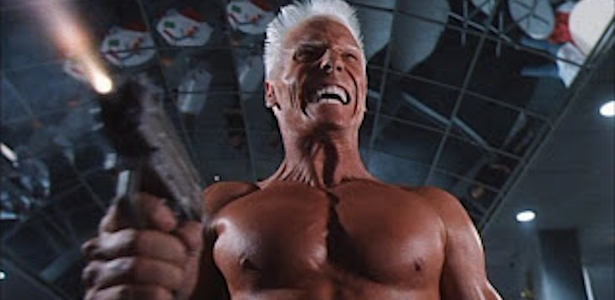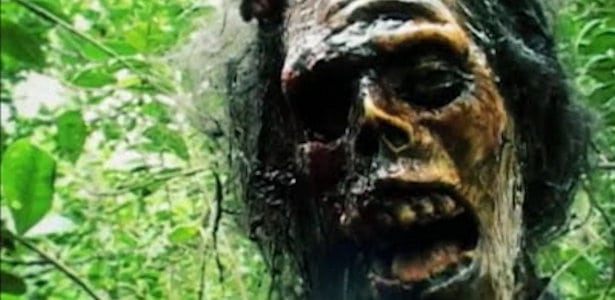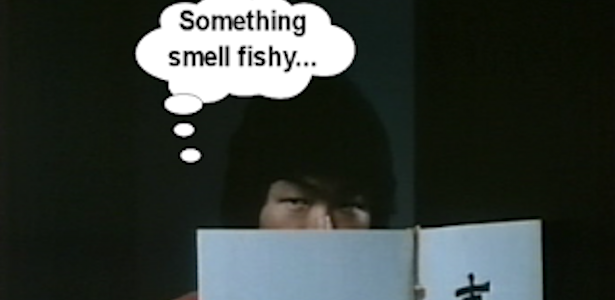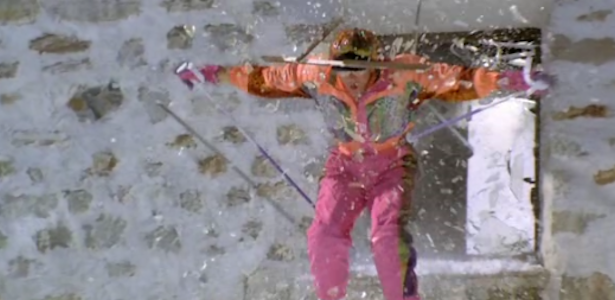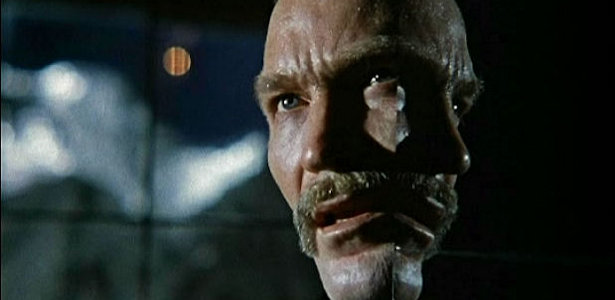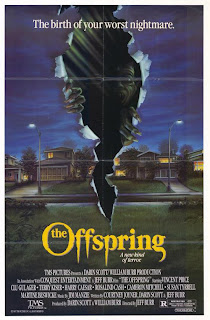From an outsider’s perspective watching Charles Band movies
over the decades can be a pretty maddening thing. I imagine Band’s career as a
pinball machine with Charlie as the ball. Slamming from one project to the
next, sometimes hitting the jackpot, sometimes draining straight down the
middle, and more often than not simply spinning wildly out of control bouncing
from one bumper to the next. One minute you could be knocked out by PUPPET
MASTER III (1991) and the next find yourself face down in a pile of DEMONIC
TOYS (1992). Amid all of the insane stories of misappropriated funds resulting
in budgets being cut in half, productions halted and lawsuits pending, Band
managed to surround himself with some very talented people. Because of this talent
and Band’s difficulty managing finances, Band’s output is a bit like certain
types of wine. Some years are much better than others, and many, once thought simplistic
and fruit forward (cheese forward,
maybe), are better sampled after being put up for a decade or two. DOCTOR
MORDRID is in no danger of overshadowing any of the proper classics of the Empire
era, but I will stick my neck out and claim it to be the best of his releases
in 1992, a vintage that produced bottles that do not mature well, no matter how
long they are put up.
When I was a kid in the '70s, there was no comic book cooler than "Doctor Strange". Never mind that I had no clue that writer Steve Englehart was running around seedy mid-'70s New York, loaded to the gills on LSD coming up with the story-lines while brain-cells popped like Orville Reddenbacher's on a Blockbuster night. While I may have missed the seemingly obvious allure of the psychedelic cosmos and consciousness expanding story-lines, no other comic book delivered surreal alien landscapes, demons summoned from alternate dimensions or a hero that was as cultured, suave and sophisticated as Stephen Strange. Brought to life in 1963 by Steve Ditko and Stan Lee, Dr. Strange started out as a successful, vain and shallow neurosurgeon who loses the ability to perform surgery after a car-accident that crushes his hands. After searching the world for a way to repair his hands and his illustrious career, Strange finds himself deep in the Himalayas in the temple of the Ancient One. He proves himself worthy by saving the Ancient One from a traitorous disciple and is taught the ways of sorcery and the mystic arts.
This sounds just as plausible as Roger Corman securing the
rights to do a sequel to the 1979 bomb STAR TREK and pulling a Weinstein, just
sitting on the property until the option expired. You’re telling me that Charles Band
ponies up a wad of cash in advance
for a high-profile property and he let it lapse without even advertising it for over-seas distribution? No sir, I'm not buying it. Don’t get me wrong. If the gloves hit the floor in Detroit bar, I’d back
Charlie’s play, no question, but let’s be honest here. Charlie is one cheap
bastard and even in the halcyon days of
Empire, the only adaptations he made were of H.P. Lovecraft stories, and I’m
reasonably certain that it was only because they were in public domain and didn’t cost him one thin dime. Nope, I'm not buying it, but I am pretty sure I know how the rumor got started, back in the early 1990s...
 In 1986 comic book legend Jack
Kirby had said goodbye to Marvel for the second time and was working intermittently for DC. The details are sketchy at best (oh like you could do better), but Kirby agreed to draw up some
concept art for a film called DOCTOR
MORTALIS, that was clearly inspired by Steve Ditko's "Doctor Strange". This was to be a part of a two-picture deal with Kirby, the other
half being a film about a paralyzed protagonist who controls a giant robot of doom,
titled MINDMASTER. Rumor has it that Kirby intended to be producer and maintain creative control. Somehow, this deal went sour. I think that it’s a safe bet to assume two things. That Band wasn't about to let anyone else have that much power within his Empire and that there
was going to be a financial obligation on Band’s part, leaving Kirby to walk after
coming up empty handed. Of course, never one to let an opportunity slip, almost
a decade later, Band decided to push forward with the projects on his own...
And when I say “forward” what I mean to say is “sideways”. MINDMASTER
transmogrified into 1993’s MANDROID and as for DOCTOR MORTALIS… Making a rip-off of a high-profile license and then ripping off the rip-off after the deal dissolves? That sounds more like the Charlie we all know and love. Think that's a little harsh? Not at all. Check out this Jack Kirby comic and an unlicensed Full Moon film which bears the exact same title and came out in 1996, only two short years after Kirby's death:
In 1986 comic book legend Jack
Kirby had said goodbye to Marvel for the second time and was working intermittently for DC. The details are sketchy at best (oh like you could do better), but Kirby agreed to draw up some
concept art for a film called DOCTOR
MORTALIS, that was clearly inspired by Steve Ditko's "Doctor Strange". This was to be a part of a two-picture deal with Kirby, the other
half being a film about a paralyzed protagonist who controls a giant robot of doom,
titled MINDMASTER. Rumor has it that Kirby intended to be producer and maintain creative control. Somehow, this deal went sour. I think that it’s a safe bet to assume two things. That Band wasn't about to let anyone else have that much power within his Empire and that there
was going to be a financial obligation on Band’s part, leaving Kirby to walk after
coming up empty handed. Of course, never one to let an opportunity slip, almost
a decade later, Band decided to push forward with the projects on his own...
And when I say “forward” what I mean to say is “sideways”. MINDMASTER
transmogrified into 1993’s MANDROID and as for DOCTOR MORTALIS… Making a rip-off of a high-profile license and then ripping off the rip-off after the deal dissolves? That sounds more like the Charlie we all know and love. Think that's a little harsh? Not at all. Check out this Jack Kirby comic and an unlicensed Full Moon film which bears the exact same title and came out in 1996, only two short years after Kirby's death: |
| Jack Kirby's "Head of the Family" (1973) and Charles Band's HEAD OF THE FAMILY (1996) |
 |
| Jack Kirby's "Mindmaster" (1986) and Charles Band's MANDROID (1993) |
The only relics that remain of this two-picture deal was a brochure for the pair of films used for promotion as well as advertisements and announcements in Variety. The really interesting thing about the brochure is that it contains a three paragraph synopsis of what, presumably, the finished film might be about. It is unknown whether this was written by Jack as part of his pitch or whether this was written by the Empire Pictures marketing department, simply to have something to help sell the concept to investors and distributors.


 |
| Jack Kirby's original pen and ink showing Dr. Mortalis and his sidekick Egghead surrounded by the forces of evil |

 |
| Joyner (the one with glasses) and Friends |
"MORDRID has kind of an odd history; when I was asked to
write it, I knew that Jack Kirby was involved, and this was the biggest thrill
for me that you can imagine. I was, and probably still am, one of King Kirby’s
greatest fans. It didn’t matter if it was Timely, or Marvel, of The Third World
series – Jack was it. I think I read Stan Lee’s announcement about Jack leaving
Marvel about thirty times before it sunk in (I was eleven, I think). Shattering
stuff! But then, came the DC period, and
that first issue of THE NEW GODS, and it was like the sun rising again.
 |
| Stan Lee's announcement in Fantastic Four #102 September 1970 |
Big disappointment that Jack was no longer involved, but I
was still super-hot to write a movie like this. I never did see a treatment,
but there were all of these fantastic Kirby concept sketches, and materials
that Charlie Band had used as promotional flyers, etc. for the film at places
like the American Film Market. Great, great stuff. I still have one of the promotional pieces
hanging on my wall – Dr. Mortalis in his cape, conjuring, with the those great
Kirby gremlins lurking in the background.
Of course, I recognized the association with DR. STRANGE right away, but
to me, it was a full-on Kirby project and that’s what I cared about," said Joyner.
Full Moon was notorious for quick productions and tight schedules. Jeffrey Combs stated in a 1994 interview with the short-lived Imagi-Movies Magazine that he wished there would have been a sequel to DOCTOR MORDRID as his biggest regret was that he had no time to prepare for the role. He continues, "I just wish that I had been a little bit more involved in the creation of the character. Although I had been talking with Charlie (Band) for quite a while, I never got to look at a script, basically until we were about ready to go. I wish that I had, because I would have liked to have had the character be little bit more active. He could have used a little more humor. I found myself just standing around reacting to what everybody else was doing, as opposed to instigating things myself." This prompted me to wonder just how fast MORDRID was put into production.
Again, Joyner was a treasure-trove of information: "Most of the first drafts for the Full Moon stuff were written in three weeks or so. MORDRID was a little longer, just because I wanted to make sure and get the effects stuff down, and for a Full Moon movie at that time, it had a broader canvas. Plus, I knew I’d be writing for Jeff Combs, who’s a great friend, and I wanted to get the Mordrid/secret identity dynamic down. I thought Jeff was great, as was the rest of the cast. Again, this is all within the context of a small film, not a studio super-production, so I am definitely not claiming we were always successful in what we were aiming for, but the effort was there."
Full Moon was notorious for quick productions and tight schedules. Jeffrey Combs stated in a 1994 interview with the short-lived Imagi-Movies Magazine that he wished there would have been a sequel to DOCTOR MORDRID as his biggest regret was that he had no time to prepare for the role. He continues, "I just wish that I had been a little bit more involved in the creation of the character. Although I had been talking with Charlie (Band) for quite a while, I never got to look at a script, basically until we were about ready to go. I wish that I had, because I would have liked to have had the character be little bit more active. He could have used a little more humor. I found myself just standing around reacting to what everybody else was doing, as opposed to instigating things myself." This prompted me to wonder just how fast MORDRID was put into production.
Again, Joyner was a treasure-trove of information: "Most of the first drafts for the Full Moon stuff were written in three weeks or so. MORDRID was a little longer, just because I wanted to make sure and get the effects stuff down, and for a Full Moon movie at that time, it had a broader canvas. Plus, I knew I’d be writing for Jeff Combs, who’s a great friend, and I wanted to get the Mordrid/secret identity dynamic down. I thought Jeff was great, as was the rest of the cast. Again, this is all within the context of a small film, not a studio super-production, so I am definitely not claiming we were always successful in what we were aiming for, but the effort was there."
 |
| Albert Band (1924-2002) |
I respected Albert greatly, not just for his horror films like I BURY THE LIVING, but also because he wrote the screenplay for Huston’s RED BADGE OF COURAGE, and had produced and written some great Euro-westerns, like THE HELLBENDERS and A MINUTE TO PRAY, A SECOND TO DIE. Any Friday afternoon, if Albert was around, we’d be in his office, discussing those films and he’d tell me stories of working with Robert Ryan and Joseph Cotton. It was fantastic, and I think one of the keys to our relationship was how much I truly valued who he was as a filmmaker. Albert Band was never just Charlie’s very nice Dad to me, he was someone with great history and experience."
When Joyner said that the assignment was in his wheelhouse, he wasn't kidding. This is clearly a project that he took to heart: "I wanted to reflect the spirit of the comic books. In
keeping with that, there were some story structure elements that seemed
constant from book-to-book in the Marvel Universe. One, that the Kirby/Lee
stories often started with a series of wild events, before the hero is involved
(or summoned). Whatever Galactis (or
whoever) is doing, is actually happening before the Fantastic Four step in, as opposed to
the heroes discovering a plan, etc. and trying to stop it. Those events were usually in New York City,
with people running in panic as something blows up or slime erupts out of the
sewers, etc. Kirby loved this one guy
who would run to the edge of the comic panel, with his hand out-stretched. When I was in grade school, I tried to draw
that guy about a thousand times – (just to show how wacky I was – if you
remember the old Marvel credit blocks with the nicknames – Jack 'King,' Smilin’
Stan, Big John Buscema, etc. I used to draw my own comics as 'Cavortin’
Courtney'! Wow.)
 The other prime element I wanted to use was the time clock
to some kind of an apocalyptic event – I recall the great visuals of the giant
sword of Aasgard, that if it ever came completely out of its sheath, that was
the end of the universe. Loved that stuff, so tried to inject those elements
within our budget, etc.
The other prime element I wanted to use was the time clock
to some kind of an apocalyptic event – I recall the great visuals of the giant
sword of Aasgard, that if it ever came completely out of its sheath, that was
the end of the universe. Loved that stuff, so tried to inject those elements
within our budget, etc.
When I came up with the museum skeletons fighting – that was
a touch of Harryhausen, and we had the great David Allen to do the animation.
Charlie was fine with that scene – I thought it would cost too much – but he
told me to go right ahead, and he made sure that we did it. I remember I had
made a major gaff by including a pterodactyl among the animals, until David
politely reminded me that the skin for the wings would be long gone, so it
couldn’t fly. Goodbye pterodactyl! One
of the Kirby elements that David and his crew caught, I think beautifully, was
the shot of the asteroid that’s now the prison. It really looks like a Kirby
drawing inked by Vince Colletta for an issue of THOR – at least to me! These little grace notes, really still excite
me about the movie, and so I guess that’s why I return to them, because I
really still wanted to capture some of the Kirby Spirit in what we were doing."
 |
| Richard Band scoring MORDRID |
 |
| Richard Band (second from left) scoring METALSTORM at Warner Studios |
So with Joyner's help the mystery is solved and as an homage to Jack Kirby and Marvel Comics, rather than a blue-band Doctor Strange adaptation, DOCTOR MORDRID has aged considerably better than other Full Moon product of the period.




